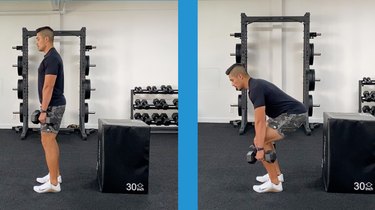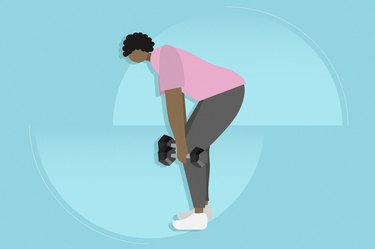


Contrary to popular belief (or perhaps your social media feed), you don't need a super-heavy barbell to build strength with deadlifts. A pair of dumbbells works perfectly fine — and offers more benefits than you might think.
- What is a dumbbell deadlift? This is a lower-body exercise that involves pushing, or hinging, your hips back, lowering a pair of dumbbells toward the floor and then standing up.
- Are deadlifts with dumbbells effective? Barbell DLs are great in their own way, but the dumbbell variation puts more focus on your body's stabilizing muscles. Also, because you can do it at home, it's easy to make a consistent part of your full-body weightlifting routine for strength and muscle gains.
- What muscles does the dumbbell deadlift work? It mainly targets your hamstrings and glutes. But with proper form (more on that below), it also helps strengthen your core, lats, shoulders and quads.
Video of the Day
Trying this exercise for the first time? Or want to find out if you're lifting the right way? Read on to learn everything you need to know about DB deadlifts.
How to Do the Dumbbell Deadlift With Perfect Form

Watch the Full Tutorial
- Stand with your feet hip-width apart, holding a dumbbell in each hand in front of your thighs, palms facing your body.
- Push your hips back behind you and soften your knees to lower the weights toward the middle of your shins.
- Check your posture: Your spine should be straight and long with your shoulders pinned back and down. The dip in your lower body should be very minimal. Brace your core to maintain this position.
- With your weight centered between your heels and balls of your feet, drive your feet into the floor to stand up as tall as possible. Imagine you are trying to push the floor away.
- Reverse the motion to lower the weights with control and repeat.
Tip
Throughout the entire move, keep the dumbbells close to your body, says California-based physical therapist Jereme Schumacher, PT, DPT. This will help you focus on your hamstrings and glutes, while keeping any stress out of your lower back.
Also, resist the temptation to try to lift the weights with your arms. Imagine your arms as ropes pulling the weights along for the ride.
5 Dumbbell Deadlift Benefits
There are many deadlift benefits you can cash in on when you add this functional fitness exercise to your strength workouts.
1. It's Great for Beginners
Although there are a million ways to do a deadlift, dumbbell variations are a great starting place, Schumacher says. Whereas a typical unloaded barbell weighs around 45 pounds, using dumbbells lets you use lighter weights.
Pro tip: If you've never done this move before, start conservatively with 15-pound dumbbells. Nail your form before pushing the weights. (Then you can consider working up toward national average deadlift weights.)
2. It's Customizable
Dumbbell exercises load each side of your body separately. During DLs, this means you can position each shoulder and arm in the way that feels best to you. (Nope, bodies aren't perfectly symmetrical!)
This can make the exercise more comfortable if you have limited mobility in your upper body or hips, Schumacher says.
3. It Evens Out Muscle Imbalances
You probably do most day-to-day activities in front of your body. Think: typing on your computer or cooking dinner. On its own, this can make the front side of your body (aka your anterior chain) stronger than your backside (your posterior chain).
Such muscle imbalances can contribute to poor posture, especially if your workout routine doesn't include a lot of posterior chain exercises.
Fortunately, this move strengthens your entire posterior chain, spanning from your calves all the way up to you shoulders. As a result, you even out imbalances, improve posture and reduce your risk of injury.
4. It Relieves Back Pain
Included in your posterior chain are all of your back muscles. Although DLs get a reputation for causing lower back pain, it's really incorrect form that's the issue.
Proper dumbbell deadlift form turns the move into a terrific back-strengthening exercise. And, according to a July 2015 study in the Journal of Strength and Conditioning Research, can even help relieve mild back pain.
5. It Works Your Whole Body at Once
DB deadlifts are a compound exercise, meaning they work several joints and muscle groups at the same time, according to the American Council on Exercise (ACE). That's why they're so effective at improving mobility and muscle coordination.
Compared with isolation exercises, which target just one muscle group at a time, compound movements are also better at building strength and muscle.
6 Common Dumbbell Deadlift Mistakes
The biggest disadvantages of dumbbell deadlifts present themselves when your form lags or you make other common DL mistakes like these.
1. Letting the Weights Drift Away From Your Body
Holding the dumbbells too far in front of your legs is a common mistake Schumacher sees with this exercise. The biggest problem is it can put unwanted stress on your lower back. On the flip side, when the weights stay close to your legs, you can really work your glutes and hamstrings.
As you lower and raise the dumbbells, they should stay within an inch or two of your legs.
2. Having Your Feet Too Wide
To target the right muscles, you want to place your feet no farther than shoulder-width distance apart, Schumacher says. When you stand with your legs too wide, your core can struggle to stabilize the weight, making you more prone to injury.
Plus, the wider your legs, the less force you can produce and the less weight you can lift. The ideal leg width varies from person to person, so take some time to experiment and find what feels strongest for you.
3. Choosing Overly Heavy Dumbbells
Two 30-pound dumbbells actually feel lighter than one 60-pound barbell. So, even if you've lifted with a barbell before, don't think you need to go super heavy with your DBs, Schumacher says.
Choose lighter weights until you become comfortable with the motion of the exercise. Try starting with 15-pound dumbbells. Increase from there.
4. Pushing Your Hips Too Far Forward
While there is definitely a hip-thrust component to the DL, you don't want to get overeager. If, at the top of the move, your hips push forward in front of your body, you dump unwanted weight into your lower back, Schumacher says.
Instead of focusing on thrusting your hips forward, try pushing through your feet to stand up as tall as possible. You want a long, neutral spine throughout the entire exercise.
5. Relaxing Your Shoulders
This dumbbell exercise can benefit the stabilizing muscles in your shoulders and upper back. You just need to make sure you keep your shoulders strong and engaged at all times. Having them loose doesn't help your muscles and can put you at risk of injury.
As you set up for the move, squeeze your shoulder blades down and back. Hold that position as you lower and raise the weight, Schumacher says.
6. Squatting
It's easy to confuse this exercise with a squat, Schumacher says. But they aren't the same thing. Squats involve hinging, or bending, the hips and knees. Deadlifts are all about the hips. Only bend your knees as far as is necessary to really get your hips back behind you.
How to Add Dumbbell Deadlifts to Your Routine
In general, everyone should aim for two strength-training workouts a week. If you're more advanced, you might lift weights on as many as six days a week. Try not to do deadlifts on consecutive days to allow your muscles time to rest and recover, LIVESTRONG.com previously reported. You can add DB deadlifts to lower-body or full-body workouts, and you can do them with other compound movements like squats and push-ups.
7 Dumbbell Deadlift Variations
1. Goblet
Instead of holding two dumbbells, hold a single one with both hands. This can help you really perfect your form.
2. Sumo
Set up with your feet slightly farther than shoulder-width apart and your toes flared out diagonally to the sides. Your arms should hang straight down in front of your body between your legs.
This deadlift variation focuses even more on your hips, and is often a more comfortable position for people who are tall.
3. Stiff-Legged
For some hamstrings emphasis, stiff-leg dumbbell deadlifts (SLDLs) are the way to go. The form here largely stays the same, but you bend your knees even less than usual. At the bottom of the move, you should feel a good stretch in the backs of your thighs.
4. Deficit
A great option for people with a lot of hamstring flexibility, this variation involves lowering the weights all the way to the floor, Schumacher says. Can you still go farther? Do the move on an elevated platform. Lower the weights past your feet with each rep.
5. Offset
Instead of holding a DB in each hand, use just one dumbbell in one hand. Leave your other arm at your side. Your core will work overtime to keep your body stable, Schumacher says.
6. Staggered-Stance
As the name suggests, the staggered-stance deadlift variation has your legs staggered. Stand with your feet hip-width apart and then step one leg behind you. Keep most of your weight in your front leg as you lower and raise the dumbbells. Use your back leg as a kickstand.
7. Single-Leg
Get ready to work on your balance: With the single-leg deadlift, you keep all of your weight in one leg and raise the other straight behind you as you lower the weights.
Was this article helpful?
150 Characters Max
0/150
Thank you for sharing!
Thank you for your feedback!